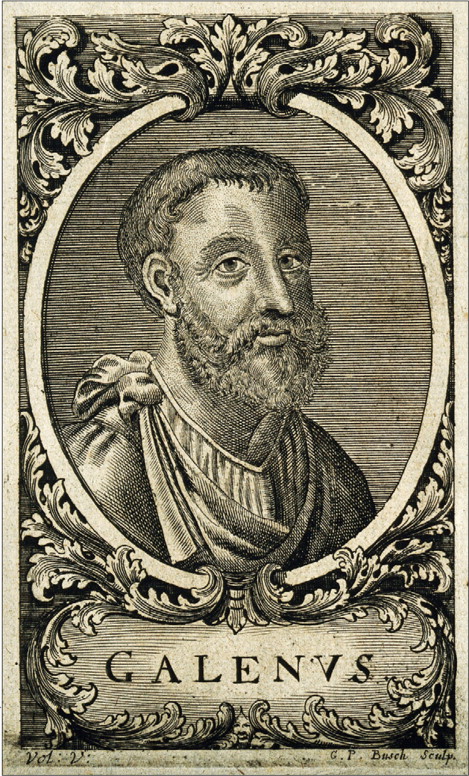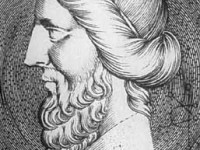
Galenus of Pergamon (127 – 216 CE)
In 129 AD, Greek physician, surgeon and philosopher in the Roman Empire Aelius Galenus also referred to as Claudius Galenus was born. Arguably the most accomplished of all medical researchers of antiquity, Galen influenced the development of various scientific disciplines, including anatomy, physiology, pathology, pharmacology, and neurology, as well as philosophy and logic.
“Employment is Nature’s physician, and is essential to human happiness.”
— attributed to Galenus, In: Day’s Collacon: an Encyclopaedia of Prose Quotations, (1884), p. 223.
Aelius Galenus – Early Years
Aelius Galenus was born in Pergamon (modern-day Bergama, Turkey) which was a major cultural and intellectual centre. It was famous for its library and attracted both Stoic and Platonic philosophers, to whom Galen was exposed at early age. Even though it was intended that Galen should study philosophy, his father changed his mind and at age 16, he began his four year studies at the Asclepieum dedicated to Asclepius, god of medicine. After the death of his father, Galen was financially independent and started traveling to Corinth, Crete, Cicilia, and Cyprus. This was followed by the medical school of Alexandria where Galen exposed himself to various schools of thought and medicine.
Physician to the Gladiators
Around the age of 28, Galen returned to Pergamon as a physician to the gladiators of the High Priest of Asia. There he learned the importance of diet, fitness and hygiene. He studied anatomy and the treatment of fractures and traumas. It is believed that only five death occurred among the gladiators during his time there, which is low compared to the sixty deaths which occurred in his predecessor’s time.
Court Physician in Rome
Around 162, Galen traveled to Rome in order to become a practicing physician there. However, he had severe conflicts with other physicians there and feared to be poisoned or exiled so he left the city. In 169 when the great plague broke out, the emperor summoned him back to Rome. He was ordered to accompany Marcus Aurelius and Lucius Versus to Germany as the court physician.[6] During the following spring however, Galen was left behind to act as physician to the imperial heir Commodus. There, Galen was able to write extensively on his medical studies. Galen was the physician to Commodus for much of the emperor’s life and treated his common illnesses. He later became physician to Septimius Severus during his reign in Rome.
Galenus of Pergamon probably passed away around the year 199. However, the sources on his death date differ.
The Unit of Body and Soul
Galen’s main medical work is the Methodus medendi, it consists of 14 books. The guiding principle here is that all phenomena in nature and in man fulfill a certain purpose. Galen understood man as a unit of body and soul, influenced on two sides, by the spiritual and by matter. He adopted the four-element doctrine developed in philosophy, according to which fire, earth, air and water in different compositions represent the basic elements of all being. He also continued the four-juice theory already developed in Hippocratic medicine, which assigned the four qualities (primary qualities) warm and moist, cold and moist, warm and dry and cold and dry to the four body juices blood, mucus, yellow bile and black bile. The four qualities of taste postulated by Galen (secondary qualities) are: Blood – sweet, mucus – salty, yellow bile – bitter, black bile – sour and hot. He also linked the four juices to the four phases of human life. Disease was for him a dyscrasia, a faulty mixture of juices. Galen attached particular importance to the examination of pulse and urine in the diagnosis of diseases.
Pharmacological Knowledge
Pathological changes in the well-balanced mixture of juices, which can be seen by heating, moistening, catching a cold or drying out the affected body parts, must be counteracted with counteracting drugs. In this context, the attraction of a part of the body to certain drugs, which could be caused by their similar nature on an elementary level, had to be taken into account. The pharmacology of the Islamic and Occidental cultural regions was oriented towards the complicated recipes of Galen until the late Middle Ages. Only under the influence of Paracelsus‘s medical teachings did the theory of the manufacture and preparation of medicines, known as galenics, lose its importance in the course of the early modern period.[7]
Sections and Vivisections
Galenus carried out extensive sections and vivisections on animals and wrote nearly 400 writings, which were combined in 70 books after his death by Oribasius (326-403). Almost a quarter of these have been preserved in the Greek original or in Latin, Arabic or Syrian translations. Until the 17th century and beyond, they served as the basis for medical teaching at universities.
Anthony Papalas, Galen’s Place in the History of Medicine, [10]
References and Further Reading:
- [1] Galen at Famous Scientists
- [2] Galen at Ancient Origins
- [3] Augustus and the Foundation of the Roman Empire, SciHi Blog, September 13, 2013
- [4] The Famous Prophecies of Nostradamus, SciHi Blog, May 4, 2018
- [5] Galen at Wikidata
- [6] Marcus Aurelius – the Philosopher on the Emperor’s Throne, SciHi Blog, March 17, 2014.
- [7] Paracelsus – a Typical Renaissance Scientist, SciHi Blog, November 11, 2012.
- [8] Works by or about Galen at Wikisource
- [9] Galen entry in the Internet Encyclopedia of Philosophy
- [10] Anthony Papalas, Galen’s Place in the History of Medicine, LaupusLibrary @ youtube
- [11] Nutton, V. (2005). “The Fatal Embrace: Galen and the History of Ancient Medicine”. Science in Context. 18 (1): 111–121
- [12] Von Staden, H. (1995). “Anatomy as rhetoric: Galen on dissection and persuasion”. Journal of the History of Medicine and Allied Sciences. 50 (1): 47–66.
- [13] Theodore J. Drizis (Fall 2008). “Medical ethics in a writing of Galen”. Acta Med Hist Adriat. 6 (2): 333–336.
- [14] Timeline of the History of Anatomy, via DBpedia and Wikidata





